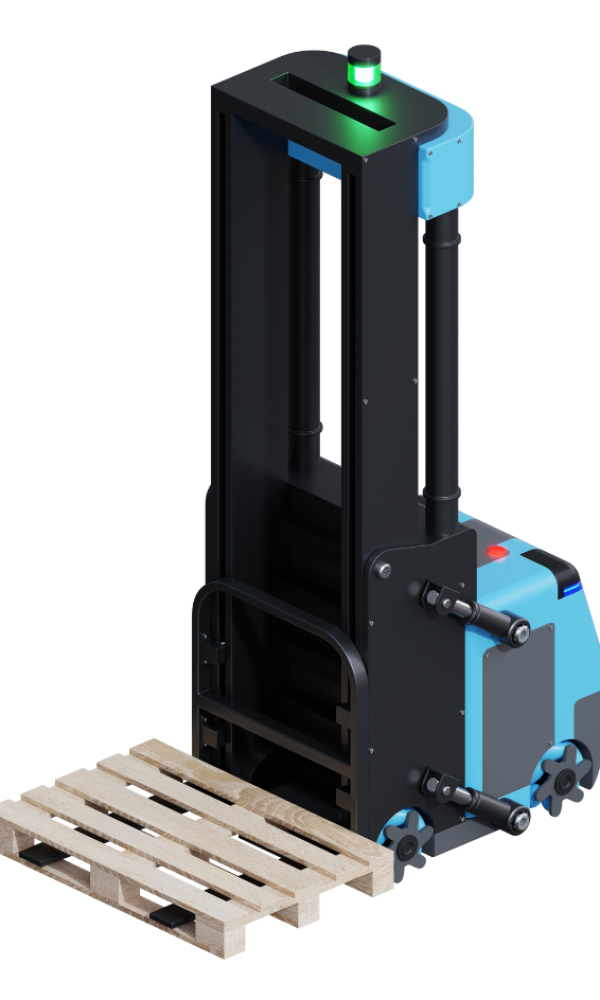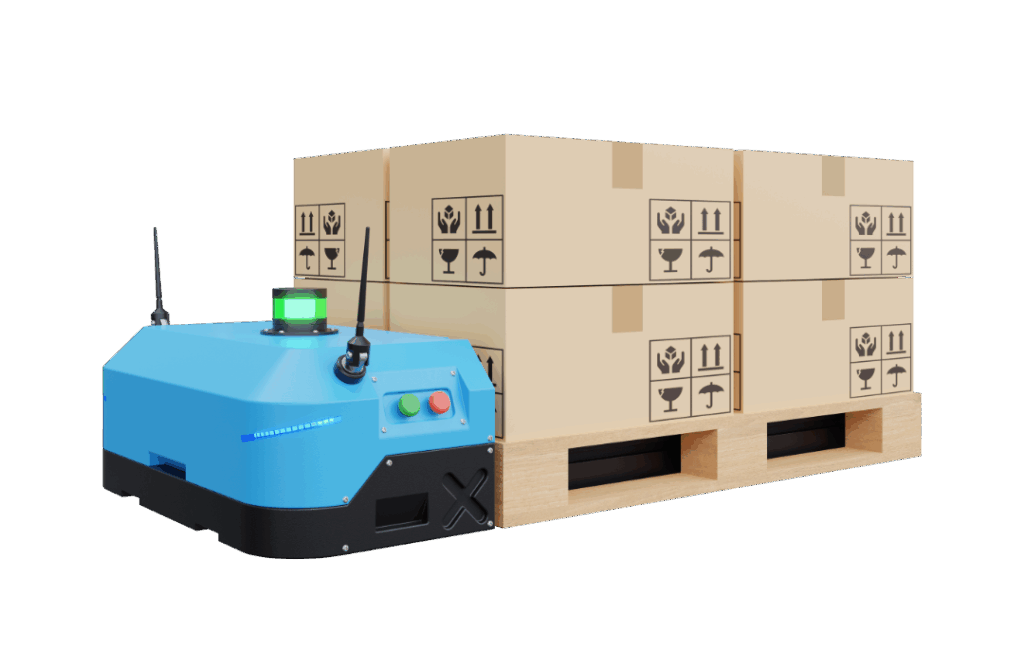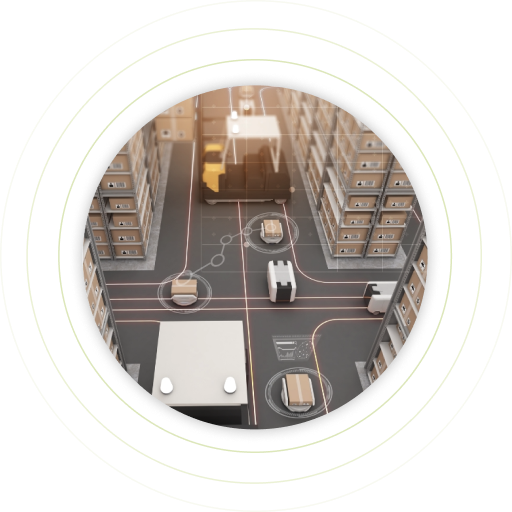Fully automated guided vehicles
You know the hurdles of your industry – time pressure, efficiency requirements and the pursuit of top performance are paramount. Challenges such as staff shortages, rising costs and a lack of automation expertise can quickly block the path to success. The use of driverless transport systems promises to optimize processes.
Automated guided vehicle systems - AGVs
Automated guided vehicles (AG Vs) are automated conveyor systems whose main task is to transport materials for production and logistics processes. They are characterized by floor-based conveying using automated guided vehicles (AGVs). These vehicles move goods of different sizes, masses and shapes along a network of routes, from simple standardized transport boxes and pallets to complex components and entire workstations.
Roadmap for the successful implementation of an AGV project
Advantages of automated transport systems
By eliminating drivers and reducing errors and accidents, operating costs can be lowered. With conventional logistics vehicles, 80% of costs are accounted for by personnel costs alone.
Self-driving vehicles can be used around the clock. Material flows are optimized through automation, which significantly increases handling capacity.
AGVs reduce the risk of accidents and injuries by using automated safety protocols. As a result, the costs of damage are minimized. The AGV expert opinion provides information on the safety of a system.
FAQ - Frequently asked questions about self-propelled transport systems
What is an automated guided vehicle system?
An automated guided vehicle system is an automated system that enables the transportation of materials and goods within a plant or facility without human intervention. These systems usually use autonomous vehicles, also known as automated guided vehicles (AGVs ), which rely on various technologies for navigation and control.
What is the difference between autonomous mobile robots (AMR), AGVs and AGVs?
Automated guided vehicles consist of one or more automated guided vehicles (AGVs) and operate on fixed routes with centralized control and are suitable for predefined tasks in stable environments, while autonomous mobile robots (AMRs) navigate flexibly and intelligently in dynamic environments by using sensors and artificial intelligence. AGVs offer less flexibility, while AMRs can automatically adapt to changes and work efficiently in real time.
What different AGVs are there?
Automated guided vehicle systems consist of one or a variety of automated guided vehicles (AGVs) such as fork-lift AGVs, piggyback AGVs, tractor AGVs, underride AGVs, assembly AGVs, heavy-duty AGVs, mini AGVs, outdoor AGVs or special AGVs, which are designed for different transportation requirements in logistics and production.
What advantages do AGVs offer?
The systems offer high scalability by expanding the number of automated guided vehicles (AGVs) and transfer stations as well as the option of implementing layout changes. Sie passen sich gut an Schwankungen in dynamischen Materialflüssen an und ermöglichen durch die Anpassung des Lastaufnahmemittels den sicheren und zuverlässigen Transport nahezu jedes Förderguts.
Are automated guided vehicles safe?
Automated guided vehicles (AGVs) are safe because they are equipped with advanced sensors, real-time monitoring, emergency shutdowns and intelligent route planning to avoid collisions and ensure consistent performance.
What applications are AGVs suitable for?
Automated guided vehicles are ideal for use in warehousing, logistics, production, hospitals, airports, retail and various industries. They can basically be used anywhere where something needs to be transported regularly.
Which AGV is best suited to my application?
We can discuss your requirements in a personal consultation and in the AGV basic check we will show you whether the system is technically feasible and economically viable. You can also take a look at our white papers, which provide you with valuable knowledge about AGV projects.
How quickly does a driverless transport system pay for itself (ROI)?
The return on investment (ROI) for an automated guided vehicle system in intralogistics depends on various factors – including the number of automated guided vehicles (AGVs) used, the degree of automation of the existing material flow, the existing infrastructure and the labor costs. In many cases, AGV solutions pay for themselves within 2 to 4 years. The AGV basic check determines the feasibility of these topics. In addition to direct cost savings in logistics through reduced personnel costs, AGVs also offer qualitative advantages such as higher process reliability, lower error rates and optimized material availability – which also has a positive impact on ROI.
How flexible are AGVs in changing production environments?
Modern automated guided vehicles are designed in such a way that they can be flexibly adapted to changing environments and processes. Route changes, layout adjustments or new transport orders can usually be implemented on the software side without physical modifications. It is important to consider scaling from the outset when planning. AGVs with freely navigating systems (e.g. SLAM navigation) in particular offer a high degree of adaptability. This means that AGVs are not only a solution for today’s requirements, but also future-proof for growing or changing production and logistics processes.


Components of automated guided vehicle systems
Automated guided vehicle systems consist of one or more automated guided vehicles (AGVs), a control system, a location determination system, a data transmission system and the infrastructure with peripheral equipment.
An automated guided vehicle (AGV ) essentially consists of a chassis, a computer, one or more drive(s), the power supply, a load handling module, a communication module, a safety component and a user interface.
If you would like to learn more about automated guided vehicle systems, we recommend our AGV basic training course or our free white papers.
Navigation methods of automated guided vehicles
Choosing the right navigation method is crucial to the success of your automated guided vehicle system. ProLog Automation offers extensive expertise to ensure that the navigation is optimally tailored to your requirements. Here is an overview of the most common methods:
1. physically track-bound
These cost-effective options include guide wires, magnetic tapes or colored lines. Vehicles follow a predetermined track that is precisely installed. Disadvantages include low flexibility and susceptibility to damage.
2. virtual track-based
Systems such as magnetic point/grid navigation or laser triangulation offer high accuracy and flexibility. They do not require physical tracks, but use digital maps or magnetic grids.
3. freely navigating (autonomous)
With contour navigation (SLAM), vehicles adapt dynamically to their surroundings. This method requires no additional infrastructure, but is susceptible to changes in the environment.


Safety concepts for automated guided vehicles
Safety comes first! AGVs are equipped with state-of-the-art safety functions to ensure smooth operation and the protection of people and systems.
- Personal protection scanner: Automatic adaptation of the safety fields to the speed of the AGV. Persons in the warning area lead to a reduction in speed or a stop.
- Ultrasonic sensors: Robust obstacle detection, insensitive to dust, moisture and ambient light.
- 3D cameras: Precise detection of obstacles such as overhanging loads or forks of other vehicles.
- Visual and acoustic warning signals: directional lights, indicators and warning beepers for maximum visibility and safety in high-traffic areas.
- Bumpers: Mechanical bumpers that stop the AGV immediately on contact.
- Emergency stop button: Manual safety devices for a quick stop in dangerous situations.
We can provide you with comprehensive advice on the safety of automated guided vehicles.
Material flow and process optimization with AGVs
- Automated guided vehicles (AGVs) make a decisive contribution to optimizing the internal flow of materials. They take over recurring transport tasks automatically and reliably – without any manual intervention. This makes processes more efficient, resources better utilized and throughput times noticeably reduced.
- Thanks to intelligent control and integration into existing systems (e.g. ERP or MES), transport orders can be dynamically prioritized and respond to changing requirements. Materials are available exactly when they are needed – “just in time” and without bottlenecks.
The result: a consistently optimized material flow, more transparency in the processes and a sustainable increase in productivity.

AUTOMATED
GUIDED VEHICLE SYSTEMS
The benefits of automated guided vehicles at a glance:
Tailored to individual requirements: AGVs can be used flexibly and can be adapted to changes.
As AGVs perform heavy and repetitive tasks, they reduce physical strain and the risk of injury for human workers.
AGVs are able to work around the clock, which significantly shortens throughput times.
AMRs work with constant precision and are not susceptible to human error, sick days or fatigue. This ensures high quality and stable processes in the internal material flow.

Although the initial investment can be high, AGVs reduce operating costs in the long term.
AGVs are equipped with sensors and advanced safety systems that prevent accidents and collisions.
AMRs are often integrated into digital systems that enable real-time monitoring and tracking of materials and products.
Whether a single vehicle or a fleet solution – AGVs can be expanded on a modular basis. This allows the automation solution to grow flexibly with the company without having to replace existing systems.
Experts Team
Satisfied customers
Projects
Arrange your AGV consultation
Our dedicated team of experts will be happy to help you further Your request is our mission to provide you with excellent service.
We look forward to your message.
Make an appointment directly
Our AGV and AMR expert Felix Imhof is available to answer any questions you may have about your AGV project.
